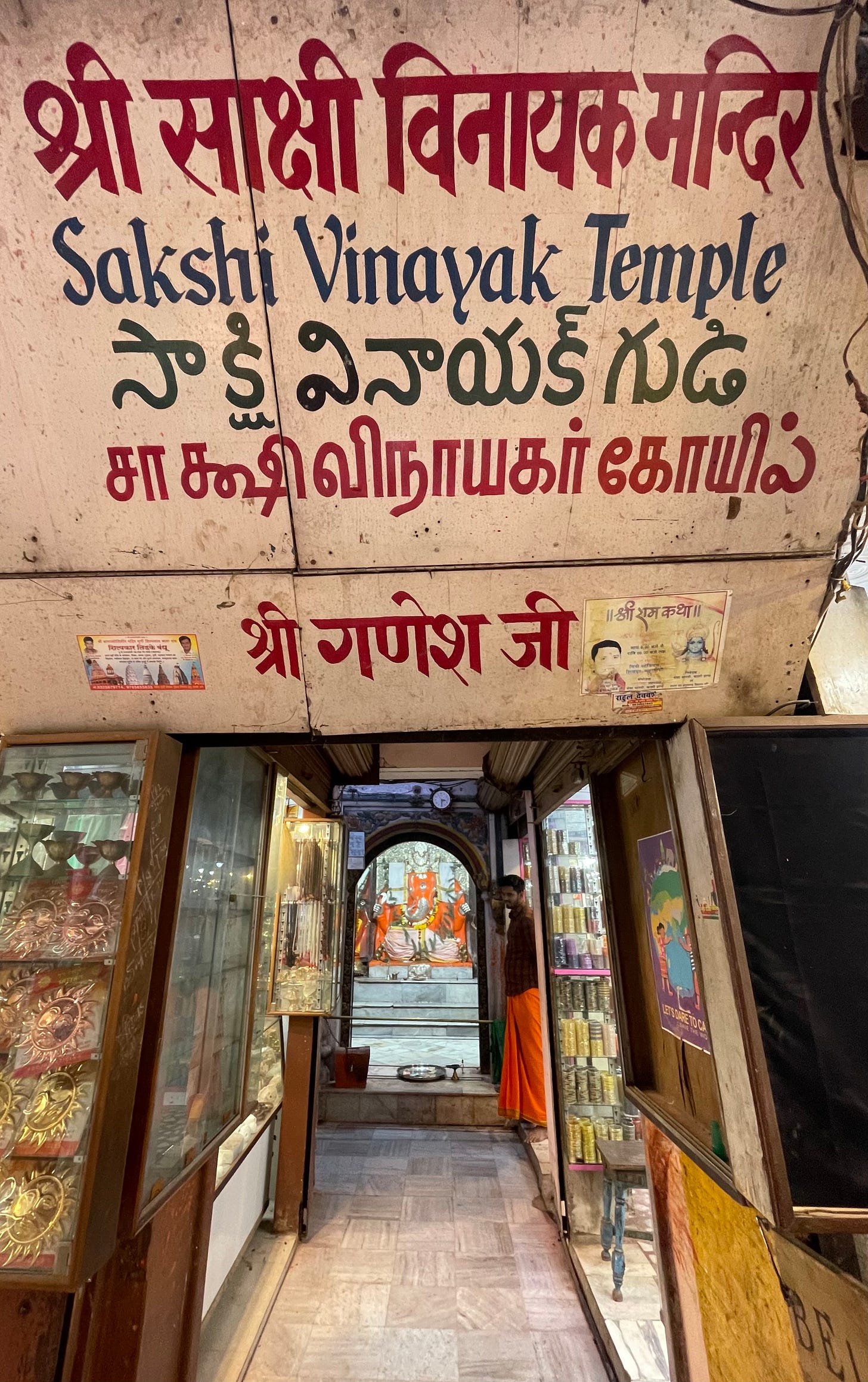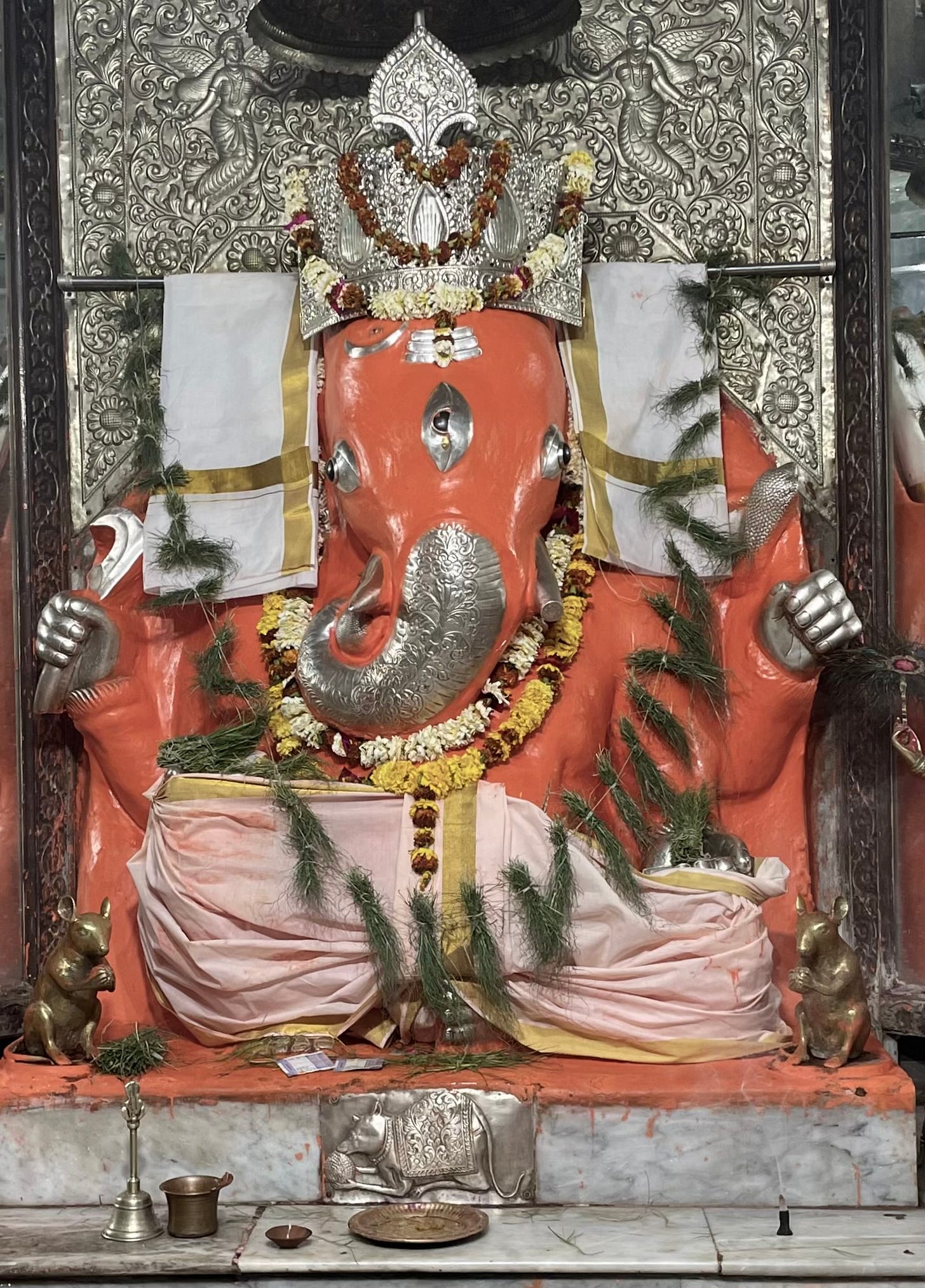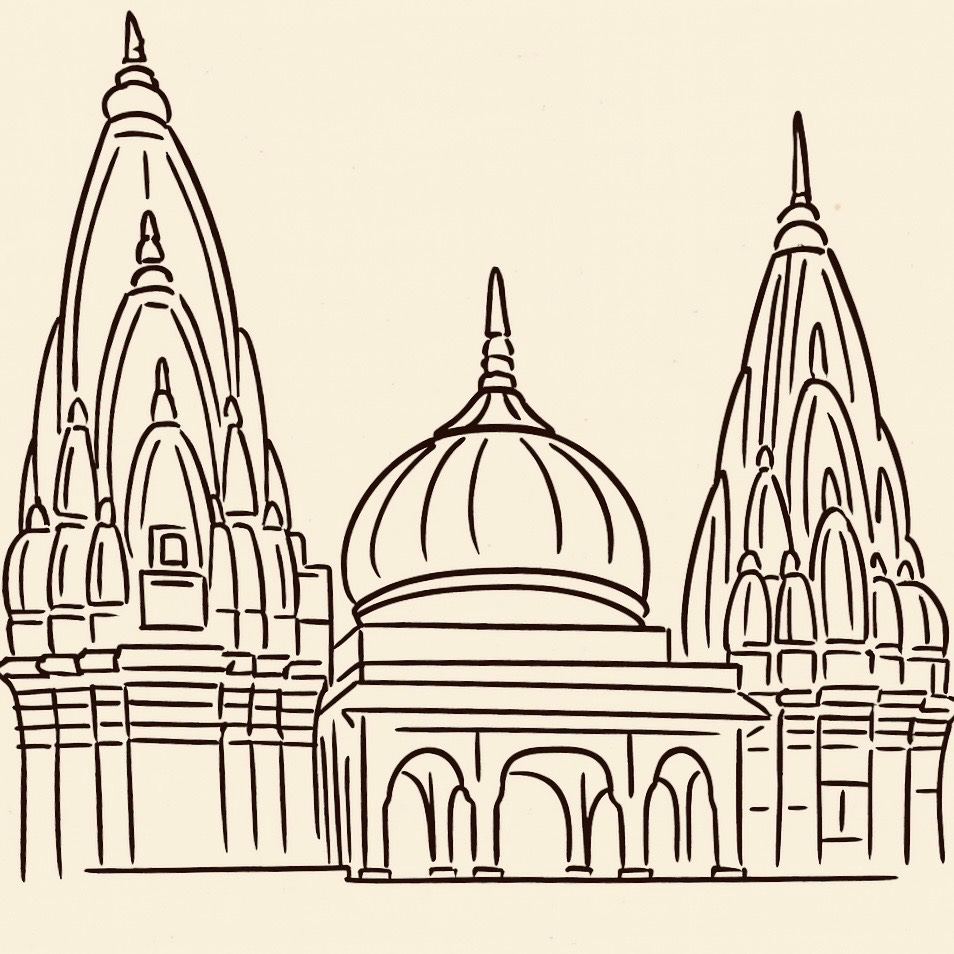Varanasi, Part IV: Following in the Footsteps of the Devoted
Accompanying a Hindu Priest to the Kashi Vishwanath Temple
Day two in Varanasi dawns fresh, though I remain unsettled, still processing yesterday’s overwhelming and complex introduction. My room is at the back, facing an alleyway. Through the open window, I see laundry hanging beside faded shutters as sounds drift up: a few words I can’t understand, distant music, and the occasional ringing of a ceremonial bell. Directly across, in a weathered cement building, a row of windows has been bricked over, the openings patched with worn wood. Near the top, a jagged line of exposed bricks forms a kind of broken border, as though something unfinished had simply been left to settle.
Turning back inside, I find an electric kettle and a few packets of Nescafé. Without further thought, I slip easily into a familiar routine of making coffee. For that moment, I could be in any hotel room, anywhere in the world - that is, until I discover, tucked into a drawer, a copy of the Bhagavad Gita, the sacred book of Hindu scripture. Its ancient verses, composed sometime between the Bible’s Old and New Testaments, speak to the universal questions we all carry: inner conflict, purpose, and the space between action and acceptance.
Opening it, I read the English introduction, which describes the Gita as a divine revelation, one that is eternally new. When approached with reverence and reflection, its text is said to reveal deep meaning at every step.
I carry that thought with me as I return to the rooftop, hoping for a breeze while watching the street below; once again, I am fascinated by all that is different in our experiences, yet the same in our questions. Varanasi remains elusive, but today offers an opportunity to experience the spiritual more directly. This morning, my travel companions and I are meeting a Hindu priest who will take us on a walk through the old city and guide us through the Kashi Vishwanath Temple.
Having been destroyed and rebuilt over the centuries since its origins in the 1st century BCE, the site where the temple stands has been sacred for over two thousand years. Dedicated to Shiva, the temple holds special significance in Varanasi, his eternal city. For many Hindus, visiting here is a lifelong goal: a spiritual culmination. For us, it is a rare opportunity to immerse ourselves in the city’s sacred rhythm.
Dressed in simple yellow cotton robes with an orange sash sewn into the hem and prayer beads around his neck, our priest greets us warmly and gestures for us to follow. He speaks little English, and his accent is strong, but I feel content in his presence, even if I can’t fully grasp his explanations.
Out the door, we are plunged once again into the hectic streets, moving through crowds and narrow alleyways. I am not navigating as I was previously; I’m simply following the yellow of his robes, trying to catch his words as he points out sites nestled within the city’s tight spaces.

We pause in front of an alleyway the leads to a small temple, identified by a sign as the Sakshi Vinayak Temple. Our priest directs us towards the entrance, where I can see a large statue of Lord Ganesha. Humbled, I realize that we are not on a tour at all, we are following the steps of the devoted. This temple is a crucial stop for pilgrims, marking the beginning of their journey. Known here as the Witness-Bearing Vinayaka, Ganesha serves as a divine witness to those who seek his blessings as they begin their pilgrimage to the city’s sacred heart: the Kashi Vishwanath Temple.

Our visit is brief, and we return to the busy street. Trying to keep up with the priest, we hop from the sidewalk to the narrow road and back again, navigating through the crowds. We weave around a cow and follow the yellow of his robes as his pace quickens, hurried now, and soon we arrive at what appears to be a government office. Inside, we receive a slip with a number I can’t read and wait at the side. The priest asks for our passports, which we hand to him.
A few minutes later, something is announced loudly, and our priest disappears. Only then does the observer in me quietly ask: What could go wrong with this scenario? But there’s nothing to be done. He’s gone. I can’t even catch a glimpse of his robes in the crowd. Trust will have to suffice.
When he returns and hands us a slip of paper, I understand: this is a standard document check for a temple as sacred and high-profile as this one. Non-Hindu visitors are welcome, but must register and be accompanied by a priest to access the inner sanctum.

Clutching our slips of paper, we follow him out of the office. Briefly back on the streets, we pass through an arched gate and arrive at a series of checkpoints, leaving our shoes at the first, along with backpacks and, eventually, our phones. Only then are we cleared to enter the temple compound.
We start on one side of the courtyard, where our priest shows us various shrines filled with pilgrims offering flowers, milk, and prayers. We’ve arrived at a fortunate time. While the temple is always busy, the lines are moving quickly, unlike in the early morning hours when devotees may queue for hours before dawn. It still feels crowded and frenzied, but I know we are fortunate. For some, this moment is the culmination of a lifetime of devotion. Entering easily feels like both a gift and a quiet responsibility.
I was unable to understand which shrines we passed in the courtyard, but later I realized that one was likely the shrine of Avimukteshwar Shiva, traditionally visited before entering the main sanctum. Avimukta means “never forsaken,” a reminder that this is a place never abandoned by Shiva.
Our priest guides us through the crowds to the line for the inner sanctum. As we join it and inch forward, the mood shifts: an electric frenzy of joy and devotion builds around us. When we pass through the doorway, the sacred stone representing Shiva, the linga, comes into view.
Surrounded by a circular, waist-high wooden barrier, this small, smooth column of stone, rounded at the top, is overflowing with offerings of honey, milk, and ghee. The single-file line coils around it, loud and chaotic, as guards urge everyone onward, preventing anyone from lingering. This particular linga is smaller than most, only about two feet high, allowing for a more intimate and immediate encounter. Devotees reach through the barrier to touch it; some taste the offerings, one even tries to climb over, while others chant with their hands raised in celebration. The atmosphere is charged, agitated. We move forward not of our own accord but are caught in the wave of bodies surrounding us; carried, jostled, and pulled deeper into the heart of the experience.
The line continues to move with urgency, directing us to the doorway on the opposite side of the sanctum. Briefly glancing back, I see no option but to exit as the frenzy continues behind us. Once outside, we pause to catch our breath, having been released from the intensity. Our priest meets us there, guiding us through the open courtyard to a space where he performs a traditional blessing.
First, he marks three lines of ash across our foreheads, symbolizing the burning away of ego, karma, and illusion. Next, a red dot of vermilion is placed between our eyes: the bindi, a blessing of awareness and inner vision. Finally, he ties a yellow-red thread around our wrists, knotted carefully, symbolizing protection and the binding of blessings.
The spirit of a blessing is always a gift; whether it comes in the name of your own god, another’s, or none at all. I didn’t understand the words our priest spoke as he offered them, but later I learned their meaning. And they remain with me:
May you be protected.
May your ignorance be burned away.
May your mind be clear.
And may Shiva’s grace accompany you on your journey.





Thank you once again for transporting me to Varanasi. Your detailed description of every thing you experienced put me right there!!
I loved reading this new instalment about your visit to Varanasi, Laurel! And can't wait for the next one.